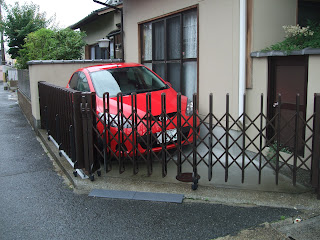* de Nederlandse tekst vind je verderop *
The first time I came to Japan, I was amazed by how
neighbourhoods look. I walked around, enjoying the atmosphere, and
wondered why these neighbourhoods look so different than
neighbourhoods in other world cities. The streets here seem to exude
a certain quietness, harmony, and spaciousness despite the fact that
many streets are just as narrow as streets in some parts of Amsterdam
or Athens or Aachen. What makes these streets so different? Perhaps
it is the unique design of traditional Japanese homes but I doubt it
as I’ve had this same sense in more modern neighbourhoods as well.
Perhaps it’s then the tiny gardens in front of those homes or the
abundant use of wood? As I wandered the streets, I observed my
surroundings and contemplated the answer.
And do you know what I found? What makes these
neighbourhoods feel so different? It is the absence of cars. Japanese
streets are not propped full with parked cars, and what a difference
that makes when these hideous yet colossal shining objects that ruin
quality of life in most cities in the world are absent. Cars are not
only the greatest producers of air pollution, they also occupy a
ridiculous amount of public space. Contemplate this: In the
Netherlands, a child has approximately four square meters of outdoor
play area. A parked car, by contrast, utilizes ten square meters and
those ten square meters are almost always on public ground.
Apparently, most people today think that using common ground for the
storage of their private property - when it is a car – is a human
right. What would be the reaction if people without cars started
parking large metal containers of ten square meters on public ground
to store their piano or their bikes? Obviously, only holy cows
are allowed to graze in common pastures.
So that’s the difference. In Japan, people do not
use public space to park their car. Cars are private property, and
therefore belong to the private domain. Safety reasons played of
course a major role in Japan’s ‘no public parking’ regulations
as fire brigades and other emergency vehicles need to be able to get
through the small and winding streets. But it is also a matter of
principle: the private and the public are strictly separated worlds.
This rule has motivated Japanese people to become very creative when
it comes to parking their car. I saw the most ingenious solutions, as
you can see in the pictures. Those who can afford it rent a parking
spot in special garages who, given the shortage of space, have come
up with smart solutions such as the car-carousel, which is a lift
like installation that can house six to eight cars. Social
anthropologist Inge Daniels claimed, in her book entitled, The
Japanese House, material culture in the modern home, that the ‘no
public parking’ rule often forces the Japanese to choose between
having a garden or having the parking spot, and although most
Japanese love nature and having a garden means a lot to them,
ultimately, they often choose to park their car on that tiny little
patch of private outdoor space that surrounds their house. The garden
is then allocated to not-quite-public-space, along the sidewalks. And
so the narrow streets look even better.
Openbare ruimte en privé
bezit
Toen ik de eerste keer in Japan was, verwonderde ik me over het straatbeeld. Ik wandelde rond, genoot van de sfeer en vroeg me af waarom deze buurten zo verschillen van wijken in andere steden in de wereld. De straten hebben een bepaalde rust en harmonie en geven een gevoel van ruimte, terwijl ze toch vaak even smal zijn als straten in bepaalde wijken van bijvoorbeeld Amsterdam, Athene of Aken. Wat maakt het hier zo anders? Misschien het speciale ontwerp van de traditionele Japanse huizen? Waarschijnlijk niet, want dezelfde gewaarwording van rust, heb ik ook in moderne buurten. Misschien de kleine tuintjes bij de voorgevels? Of het vele hout dat je ziet? Al lopend door de straten, observeerde ik de omgeving op zoek naar een antwoord op mijn vraag.
En weet je wat ik ontdekte?
Weet je waarom je de buurten in Japan zo anders ervaart? Er staan
hier geen auto's langs de weg. De straten zijn niet vol gepropt met
geparkeerde auto's. En wat een verschil is dat, als die lelijke,
glimmende kolossen, die ook nog eens de kwaliteit van leven in de
meeste steden ruineren, afwezig zijn! Auto's zijn niet alleen de
grootste luchtvervuilers, ze nemen ook nog eens een belachelijke
hoeveelheid openbare ruimte in beslag. Voorbeeldje? In Nederland is
er per kind gemiddeld vier vierkante meter speelruimte. Een
geparkeerde auto neemt tien vierkante meter in beslag, meestal gewoon
op de openbare weg. Voor autobezitters lijkt het inmiddels een
mensenrecht aanspraak te maken op publiek bezit voor prive
doeleinden. Want denk maar niet dat iemand die geen auto heeft een
container van tien vierkante meter voor zijn woning mag plaatsen voor
zijn piano of fietsen. Nee, alleen de heilige koeien mogen in
gemeenschappelijke weides grazen.




Net terug uit Japan (het was mijn tweede bezoek aan dit land) kom ik via een tip van Godelieve Engbersen op jouw blog terecht. Ik heb me inderdaad ook al vaak afgevraagd waarom Japanse steden zoveel rustiger lijken (minder herrie was mijn conclusie). Jouw blog wees me op het ontbreken van geparkeerde auto's. Ik heb het wel gezien maar blijkbaar niet echt waargenomen. Maar inderaad: dat is het!
ReplyDeleteAnnelieke Koster